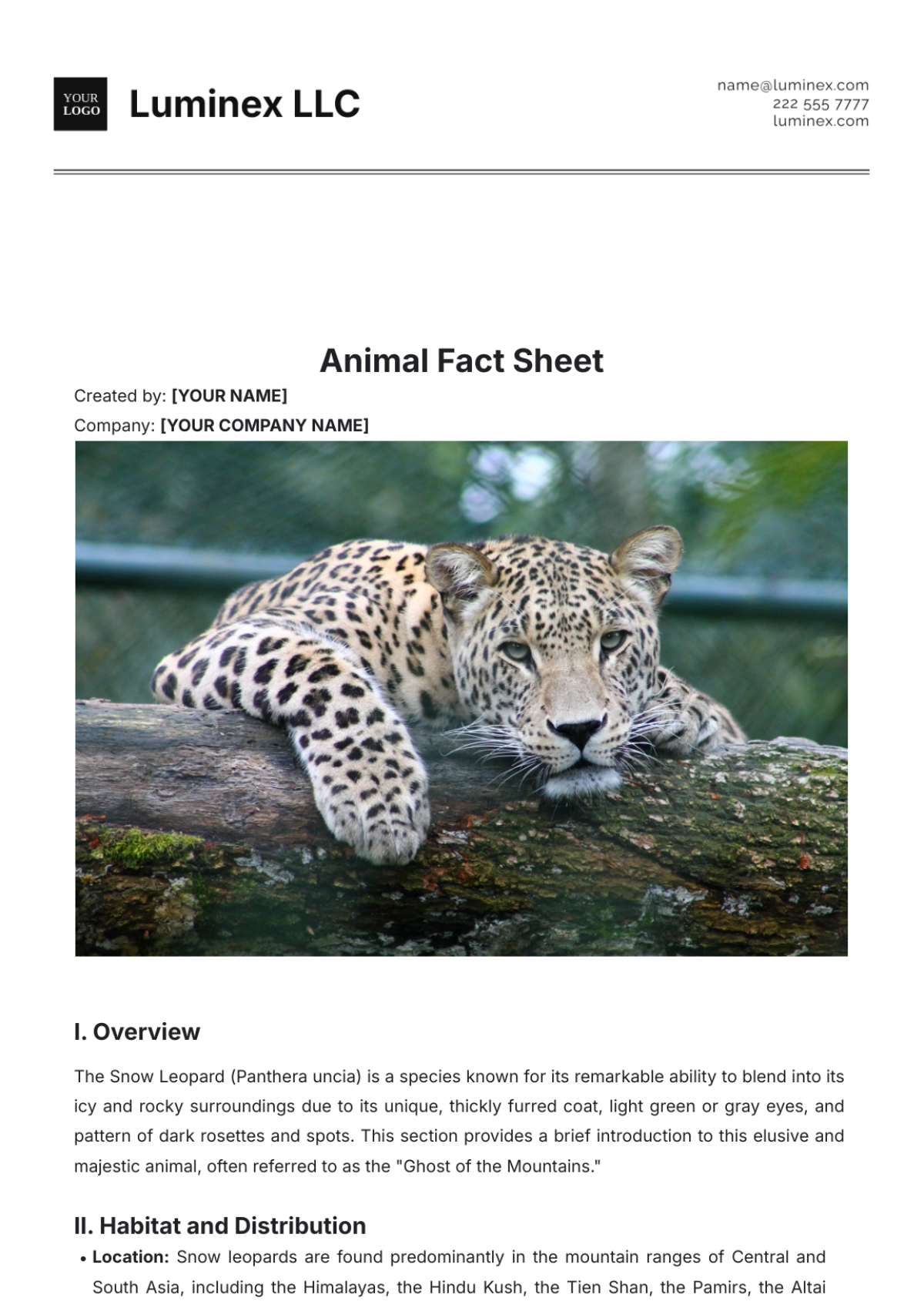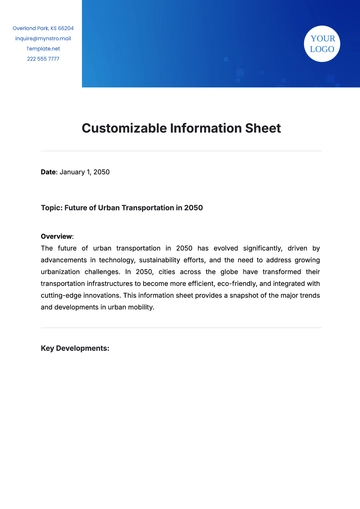Free Animal Fact Sheet

Created by: [YOUR NAME]
Company: [YOUR COMPANY NAME]

I. Overview
The Snow Leopard (Panthera uncia) is a species known for its remarkable ability to blend into its icy and rocky surroundings due to its unique, thickly furred coat, light green or gray eyes, and pattern of dark rosettes and spots. This section provides a brief introduction to this elusive and majestic animal, often referred to as the "Ghost of the Mountains."
II. Habitat and Distribution
Location: Snow leopards are found predominantly in the mountain ranges of Central and South Asia, including the Himalayas, the Hindu Kush, the Tien Shan, the Pamirs, the Altai Mountains, and several other ranges.
Climate: They thrive in cold, arid climates, frequently experiencing harsh, snowy winters and cool to moderately warm summers.
Geographical Features: The typical habitat of the snow leopard includes rugged terrain with rocky outcrops and steep cliffs. These environments provide excellent camouflage and vantage points for hunting, as well as protection from larger predators.
III. Physical Characteristics
Size: Snow leopards are medium-sized big cats, typically measuring about 90 to 130 centimeters (3 to 4.3 feet) in body length, with their tails adding an additional 80 to 100 centimeters (2.6 to 3.3 feet).
Weight: They usually weigh between 22 to 55 kilograms (48 to 121 pounds), with males generally being larger and heavier than females.
Color: Snow leopards have a thick, soft coat that is typically smoky gray to yellowish tan, covered in dark gray to black open rosettes and spots. This coloration provides effective camouflage in their natural, rocky habitat.
Distinctive Traits: One of the most unique features of the snow leopard is its long, thick tail, which helps maintain balance on the rugged and steep terrain of its habitat. The tail can also be wrapped around the resting animal for added warmth. Additionally, snow leopards have large, wide paws that act as natural snowshoes, helping them tread on soft snow and preventing them from sinking.
IV. Diet
The primary diet of Snow Leopard (Panthera uncia)includes:
Primary food source: Snow leopards mainly prey on wild ungulates such as blue sheep (bharal), ibex, and argali. These large hoofed mammals constitute the bulk of their diet and provide the necessary fat and protein content needed to survive in the harsh mountainous environment.
Secondary food source: When large prey is scarce, snow leopards also hunt smaller animals such as hares, birds, marmots, and even livestock. They are opportunistic feeders and will adjust their diet based on the availability of prey.
Feeding Habits: Snow leopards are solitary hunters, typically stalking their prey from above and using the rugged terrain to conceal their approach. They use their powerful hind legs to launch attacks over distances or down steep slopes, aiming to deliver a fatal bite to the neck or throat.
V. Behavior
Social Structure: Snow leopards are predominantly solitary animals, except during the mating season or when females are raising their cubs. They are highly territorial and use scent markings to define their space and communicate with other snow leopards. Each individual may have a territory that ranges from 20 to 100 square kilometers, depending on the local prey availability.
Activity Cycle: Snow leopards are crepuscular, being most active during dawn and dusk. This behavior helps them avoid extreme temperatures and maximizes their chances of catching prey, which are also more active during these times.
Reproductive Behavior: Snow leopards mate between January and mid-March, using scent to find each other and mating multiple times. Females give birth to 1-5 cubs after three months, which are completely dependent on her. Cubs start hunting with their mother at three months, are weaned by ten months. They stay with their mother until they are 22 months old to learn survival skills and establish their territories.
VI. Conservation Status
The Snow Leopard (Panthera uncia) is listed as Vulnerable due to habitat loss, poaching, and climate change. Conservation efforts include:
Protected Areas: Establishing zones where snow leopards can live and breed without human interference.
Community Involvement: Implementing programs that compensate livestock losses and reduce conflicts between snow leopards and local communities.
International Cooperation: Countries are working together on research and conservation to protect snow leopard populations across national borders.
VII. Interesting Facts
Some fascinating aspects of the Snow Leopard (Panthera uncia) include:
Tail Use: Snow leopards have exceptionally long tails, almost the same length as their body, which they use for balance while navigating rocky terrain and for warmth by wrapping it around themselves when resting.
Silent Stealth: Snow leopards are capable of moving silently across their mountainous terrain, an essential skill that allows them to approach prey without detection. Their padded paws absorb sounds and soften their footsteps.
High Altitude Adaptations: Snow leopards are among the few mammals capable of living at extremely high altitudes, usually ranging from 3,000 to 4,500 meters above sea level. They have adapted to low oxygen levels with larger nasal cavities and unique hemoglobin in their blood.
Contact Information
For more information, please contact [YOUR NAME] at [YOUR EMAIL] or visit our website at [YOUR COMPANY WEBSITE].
- 100% Customizable, free editor
- Access 1 Million+ Templates, photo’s & graphics
- Download or share as a template
- Click and replace photos, graphics, text, backgrounds
- Resize, crop, AI write & more
- Access advanced editor
Unlock the exciting world of animals with the Animal Fact Sheet Template offered by Template.net. This downloadable and printable resource is fully customizable and editable in our AI Editor Tool, allowing you to tailor each sheet to meet your educational needs. Perfect for teachers, students, and animal enthusiasts, this template helps you organize and present animal facts clearly and engagingly.
You may also like
- Attendance Sheet
- Work Sheet
- Sheet Cost
- Expense Sheet
- Tracker Sheet
- Student Sheet
- Tracking Sheet
- Blank Sheet
- Information Sheet
- Sales Sheet
- Record Sheet
- Price Sheet
- Plan Sheet
- Score Sheet
- Estimate Sheet
- Evaluation Sheet
- Checklist Sheet
- Bid Sheet
- Call Log Sheet
- Bill Sheet
- Assessment Sheet
- Task Sheet
- School Sheet
- Work From Home Sheet
- Summary Sheet
- Construction Sheet
- Cover Sheet
- Debt Spreadsheet
- Debt Sheet
- Client Information Sheet
- University Sheet
- Freelancer Sheet
- Bookkeeping Sheet
- Itinerary Spreadsheet
- Scorecard Sheet
- Run Sheet
- Monthly Timesheet
- Event Sheet
- Advertising Agency Sheet
- Missing Numbers Worksheet
- Training Sheet
- Production Sheet
- Mortgage Sheet
- Answer Sheet
- Excel Sheet





























